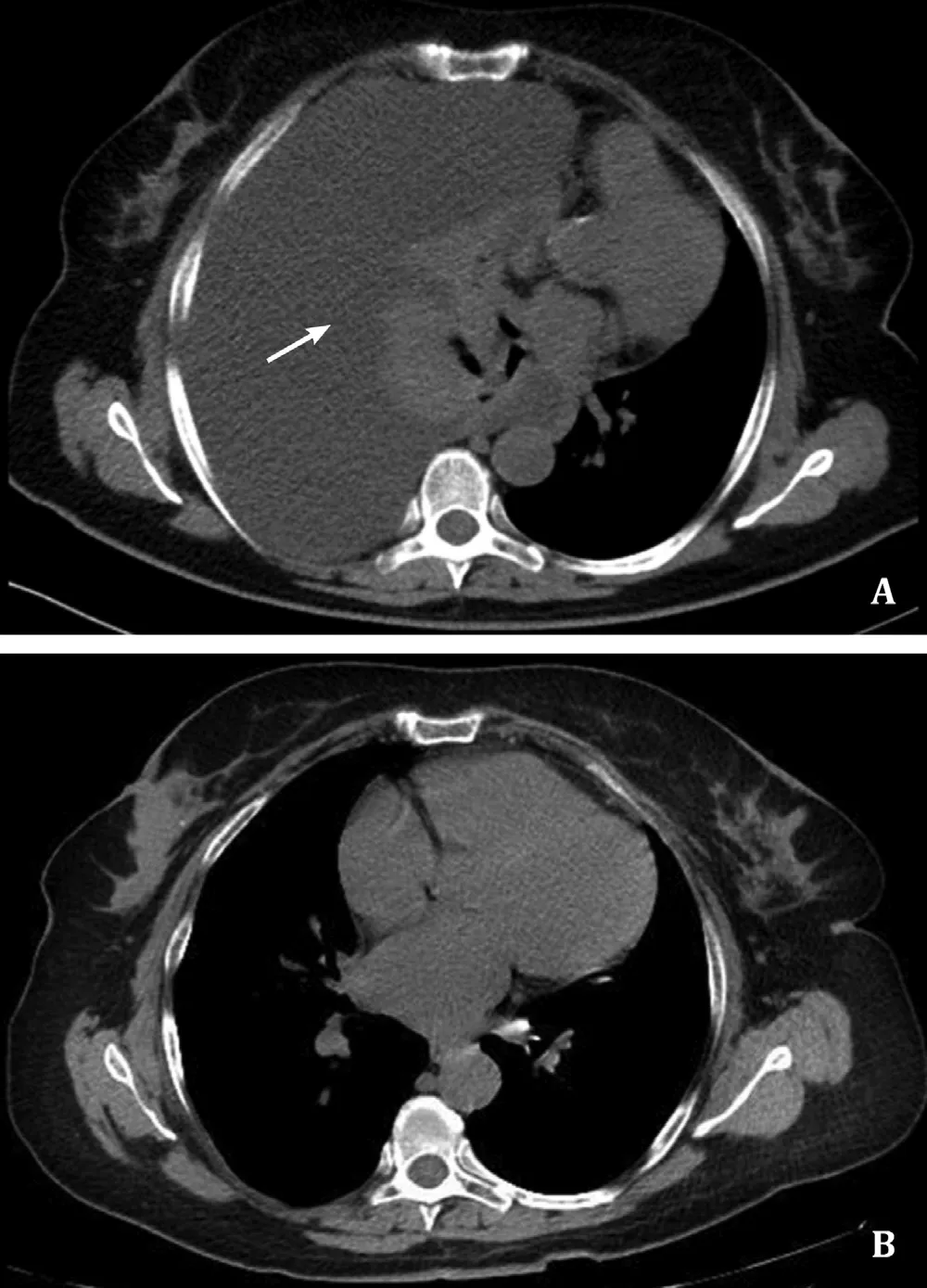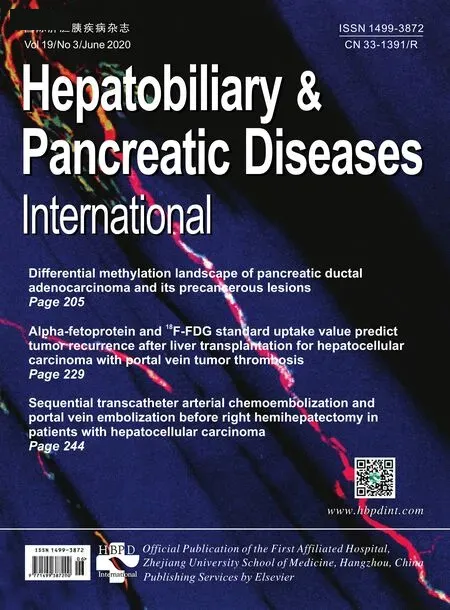Transjugular intrahepatic portosystemic shunt for a patient with chylothorax in cryptogenic/metabolic cirrhosis
2020-07-07FrncescoCocomzziNicolMurizioCstellnetAntoninoCstellnetFioFucilliEnzoIerrdiAlfredoDiLeo
Frncesco Cocomzzi , Nicol Murizio Cstellnet , Antonino Cstellnet ,Fio Fucilli , Enzo Ierrdi , Alfredo Di Leo , ∗
a Section of Gastroenterology, Department of Emergency and Organ Transplantation, University of Bari, Bari, Italy
b Radiology Unit, IRCCS De Bellis, Castellana Grotte, Bari, Italy
TotheEditor:
Chylothorax is a rare pleural effusion with a milky appearance due to triglycerides and chylomicrons [1] ; About 1% of cases are associated with liver cirrhosis [2] . Incidentally, it has been hypothesized that chylothorax originates from the passage of chylous ascites into pleural cavity owing to diaphragmatic defects and negative thoracic pressure [3] . Chylous ascites represents the 1% of ascites in liver cirrhosis (1:20,0 0 0 hospitalizations) [4] .Pathophysiological mechanism is mediated by increased hepatic and gastrointestinal lymphatic flow due to portal hypertension [5] ,which may lead to lymphatic vessel spontaneous rupture [6-8] .The gold standard for diagnosis of chylothorax is the presence of chylomicrons in the fluid [9 , 10] . If this analysis is not available,triglycerides concentration>110 mg/dL is the diagnostic cut-off value. In addition, other diagnostic criteria include pleural/serum triglycerides ratio>1 and pleural/serum cholesterol ratio<1 [9] .In the case of liver cirrhosis, according to Light’s criteria, chylothorax is usually a transudate fluid [11] , which is defined by the absence of the following parameters: (a) pleural fluid/serum protein level>0.5; (b) pleural fluid lactic/serum lactic acid dehydrogenase (LDH) level>0.6; (c) pleural fluid LDH level>2/3 upper serum normal limit [12] . Therapeutic approach can be both conservative and interventional. The objective of conservative treatment is lymphatic vessel spontaneous closure [10] . In cirrhotic patients, portal decompression may be a successful option [5 , 13] . A review of Tsauo et al. [5] reported that 7 patients with chylothorax and liver cirrhosis were treated with transjugular intrahepatic portosystemic shunt (TIPS). Despite the putative effectiveness, the small sample does not allow providing final recommendations about its use in first-line.
Herein, we report a further case of chylothorax in a patient with liver cirrhosis successfully treated with TIPS. A 62-year-old woman with hypertension, diabetes, dyslipidemia, overweight (BMI 29 kg/m2) and a diagnosis of cryptogenic liver cirrhosis for 7 years was admitted for dyspnea. In the year before admission, two hospitalizations for dyspnea with a massive hydrothorax treated by thoracentesis had occurred. Interestingly,two weeks before admission the patient underwent an accidental right thoracic trauma, not subjected to further investigations.At admission, the following parameters were observed: blood pressure 100/70 mmHg, heart rate 100 beats per minutes, O 2 saturation at room air 97%. At chest auscultation, vesicular murmur was completely absent on the right side. Abdominal ultrasound scan did not show ascites despite the presence of hepatomegaly with inhomogeneous echoic pattern and splenomegaly (longitudinal diameter: 15 cm). The most significant laboratory values were: arterial pH 7.47, pO 2 70 mmHg, pCO 2 34 mmHg; hemoglobin 10.5 g/dL; leukocytes 5.91 ×109/L; platelets 123 ×109/L; creatinine 1.09 mg/dL; glucose 243 mg/dL; triglycerides 198 mg/dL; total bilirubin 0.26 mg/dL; gamma-glutamyl-transpeptidase ×2.93 upper normal limit; albumin 3.4 g/dL; international normalized ratio 1.03. Model for end-stage liver disease (MELD) score was 8 and Child-Pugh A6. Chest X-ray showed massive right pleural effusion with mediastinal contralateral shift; computed tomography (CT) scan of the chest confirmed the picture and excluded malignancy ( Fig. 1 A). A thoracic drainage was placed at entry and revealed the presence of a milky fluid. Bacterial culture showed positivity forStreptococcusMitissuccessfully treated with ceftriaxone. Cytological examination was negative. Chylothorax was confirmed by triglyceride values of 486 mg/dL in pleural fluid. According to Light’s criteria (LDH ratio 0.45, total protein ratio 0.17, LDH effusion 54 U/L) the fluid appeared to be a transudate. CT scan, magnetic resonance investigation and positron emission tomography confirmed the features of liver cirrhosis and showed the presence of abdominal lymphadenopathies( ≥2 cm) and splenic nodules (angiomas). Doppler of portal system demonstrated hypertension, confirmed by the endoscopic finding of esophageal F2 varices and congestive gastropathy. Histological evaluation of the lymph nodes, surgically removed by laparoscopy, and bone marrow biopsy excluded lymphoproliferative disorders. Lymphoscintigraphy, performed for thoracic trauma history did not show any lesion. The angiotensin converting enzyme(ACE) assay excluded sarcoidosis. Quantiferon detection was negative. The patient was first managed with long chain triglyceridefree diet and octreotide [9] without benefit. Therefore, she was treated with total parenteral nutrition (TPN). This approach resulted in chylous aspect of pleural fluid disappearance, but daily losses remained relevant (about 4 L/day). The patient underwent a series of chylothorax complications: marked hypotension,pre-renal acute kidney failure, hypoproteinemia, lymphopenia and septic episodes. Because of the refractoriness of the picture and the presence of portal hypertension (esophageal F2 varices, congestive gastropathy, splenomegaly) a TIPS was placed. Pre-TIPS portosystemic gradient (PSG) was 13 mmHg (portal vein pressure 21 mmHg, free hepatic venous pressure 8 mmHg). After endoprosthesis (VIATORRR○GORER○10 ×60 mm), between right portal and hepatic veins, PSG decreased to 10 mmHg. Chest drainage was removed after few weeks. Three episodes of overt encephalopathy occurred within two months following TIPS. They were reversed with rifaximin, lactulose and branched chain amino acid administration. After 30 months of follow-up, the patient did not need any thoracentesis, paracentesis or oxygen supplementation. Last CT scan did not show any pleural fluid ( Fig. 1 B).

Fig. 1. A Chest CT scan shows massive right pleural effusion with a mediastinal contralateral shift (arrow); B Chest CT scan shows complete disappearance of right pleural effusion.
We described a case of chylothorax in a subject with liver cirrhosis, occurred after thoracic trauma (triggering factor, even if herein with supposed, but not demonstrated role) and in the absence of ascites. Our case showed some peculiarities rarely reported in literature: only three cases of chylothorax, previously treated with TIPS in cirrhotic patients, were not associated with evident ascites [3 , 5 , 6] and only another case had a previous diagnosis of cryptogenic cirrhosis [3] . Really, this diagnosis dates back to a period when little attention was paid to nonalcoholic steatohepatitis (NASH) and its possible evolution into cirrhosis. In both our case and the one by Kikolski et al. [3] , the presence of metabolic conditions predisposing to NASH (diabetes, arterial hypertension, dyslipidemia, overweight) make the metabolic origin of liver disease quite presumable. Interestingly, in the review by Tsauo et al. [5] the mean duration of follow-up of patients with chylothorax associated with cirrhosis was 12.8 months (range 0.6-35 months). Our patient underwent a 30-month follow-up and, unlike the case described by Tsauo et al. [5] (35-month follow-up with final death for hepatocellular carcinoma), our patient at 30th month showed both chylothorax definitive resolution and symptom absence except for three episodes of overt encephalopathy limited to the two months following TIPS. A final aspect of this case is that clinical result was excellent despite a low PSG reduction (3 mmHg) after TIPS in relation to similar reports [3 , 5] .
CRediT authorship contribution statement
Francesco Cocomazzi:Data curation, Writing - original draft,Writing - review & editing.Nicola Maurizio Castellaneta:Data curation.Antonino Castellaneta:Data curation.Fabio Fucilli:Investigation.Enzo Ierardi:Writing - review & editing.Alfredo Di Leo:Supervision, Writing - original draft, Writing - review & editing.
Funding
None.
Ethical approval
The patient gave informed consent for diagnostic and therapeutic procedures and the publication of the paper in anonymous form.
Competing interest
No benefits in any form have been received or will be received from a commercial party related directly or indirectly to the subject of this article.
杂志排行
Hepatobiliary & Pancreatic Diseases International的其它文章
- Sinusoidal obstruction syndrome related to tacrolimus following liver transplantation
- Synergistic interaction between thioredoxin inhibitor 1-methylpropyl 2-imidazolyl disulfide and sorafenib in liver cancer cells
- Laparoscopic combined with thoracoscopic transdiaphragmatic hepatectomy for hepatitis B-related hepatocellular carcinoma located in segment VII or VIII
- Deceased donor liver transplantation for Budd-Chiari syndrome:Long-segmental thrombosis of the inferior vena cava with extensive collateral circulation
- Diagnostic value of contrast-enhanced ultrasonography for intrahepatic cholangiocarcinoma with tumor diameter larger than 5 cm
- Effect of six-stitch pancreaticojejunostomy on pancreatic fistula: A propensity score-matched comparative cohort study
